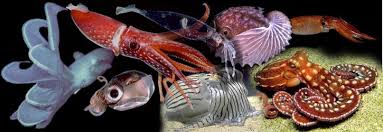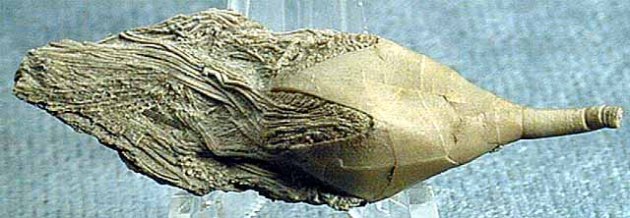Home » Posts tagged 'Ozark plateau'
Tag Archives: Ozark plateau
The answer to last week’s Mystery Monday
The answer to last week’s Mystery Monday fossil was supposed to be posted last Friday, which didn’t get done. I am going to have to make some changes in the schedule or change the way I do things because I simply don’t have the time to post a new fossil and give a full discussion of it every week and do anything else. So if you have any suggestions on how you think changes would be best done, let me know. I could cut back to every two weeks; still give a fossil every week, but not go into much discussion of what it is each week; or some other possibility. Let me know your preferences.
At any rate, for the last Mystery Monday fossil, I posted this little fossil.
What we have here is a little goniatite ammonoid that has been pyritized, meaning that the shell has been replaced with pyrite. This type of fossilization is pretty common. As the bacteria eat the organism, some of them will release sulfur, which then combines with the hydrogen in the water to form hydrogen sulfide. When it precipitates out of the water, it usually does so as pyrite. In some cases, like in this one, the pyrite crystals can replace the organism so well that it makes a detailed copy of the original. For obvious reasons, this type of fossilization is called replacement, in which the original oranism is replaced with a mineral, be it calcium carbonate, iron, opal, quartz, or in this case, pyrite.
So what are goniatite ammonoids? Ammonoids are part of the group (often called phylum, but for various reasons the specific rank of the group is often no longer used) Mollusca; which includes snails, (gastropods), clams (Bivalvia, meaning two shells, or less commonly, Pelecypoda, meaning hatchet foot), and the Cephalopods.
Cephalopods include the squids and octopuses, as well as the Nautilus, which is what concerns us here. If you aren’t familiar with a nautilus, think of a squid inside a spiral shell. Squids used to have shells, either long, straight ones or curved and coiled ones. The only one left of these shelled squid is the nautilus. However, you can still see the remnant of the shell in an internal structure called a squid pen, or in the case of cuttlefish, the cuttlebone. In either case, they are the last vestiges of the external shells we see in the nautilus and the ammonoids.
During the Paleozoic and Mesozoic Eras, ammonoids were much more common and much more diverse. During the Jurassic and Cretaceous Periods during the Mesozoic, the type of ammonoids that were most common were the more familiar fossils known as ammonites. Goniatites were much earlier and lived during the Paleozoic.
How does one tell the difference between the different types of ammonoids? Look at the internal partitions. These partitions, called septae, separate the chambers within the shell. As the animal grows, it adds material to the edge of the shell, making it larger and larger at that end. Once the shell gets big enough, the animal will create a new partition in the back, separating the current body chamber from the earlier, smaller one. A small hole is left in the septae so the siphuncle, a thin tube, can pass through, connecting all the previous chambers. The siphuncle could then be used to pump water or gas in and out of the chambers so they could be used as ballast, allowing fine control of their buoyancy.
 The septae in the nautiloids (the group of ammonoids containing the modern nautilus) are all very smooth, forming a nice curve. The nautiloid septae curve inwards, whereas the ammonoids curve outwards to some extent. Ammonoid septae are also much more complex. Goniatites, the earlier forms, had simple wavy septae. Ceratitic ammonoids created septae in which the waves were more jagged, with what often looks like little saw-toothed crenulations. The later ammonites (many people call all of them ammonites, but this term more properly only refers to the more derived subset) had very complex septae, showing several smaller wave patterns overlaid upon the larger wave.
The septae in the nautiloids (the group of ammonoids containing the modern nautilus) are all very smooth, forming a nice curve. The nautiloid septae curve inwards, whereas the ammonoids curve outwards to some extent. Ammonoid septae are also much more complex. Goniatites, the earlier forms, had simple wavy septae. Ceratitic ammonoids created septae in which the waves were more jagged, with what often looks like little saw-toothed crenulations. The later ammonites (many people call all of them ammonites, but this term more properly only refers to the more derived subset) had very complex septae, showing several smaller wave patterns overlaid upon the larger wave.
Ammonoids were very common in the Paleozoic and Mesozoic and were found throughout the oceans of the time. They typically lived in shallow marine environments all over the world. They also evolved rapidly, so new species tended to appear and disappear on a fairly regular basis. This abundance, diversity, and rapid turnover make them prime index fossils. Index fossils are those fossils which are useful for dating the rock layer and correlating the layer from one spot to another. Using index fossils allows us to piece together a complete sequence of events even if there is no one place that has the entire sequence of rocks preserved. As a result, any fossils that can be used as index fossils become very important to people trying to figure out the history of life on earth, such as this little ammonoid. If you want to find one for yourself, look in almost any of the limestone or chert formations in the Ozark mountains. There are plenty.
Fossil Friday, Having a Blast
It’s Friday, which, along with the anticipations of the weekend, means it’s time for the reveal of this week’s Mystery Monday fossil. We’ve had guesses of starfish, aka sea star, and sea urchins. Both are close. Were you able to guess it?
This fossil is of Pentremites, a echinoderm in the group Blastoidea, so a relative of both sea stars and sea urchins. Like them, you would have found them in shallow marine communities in fairly clear water, if they still lived. Blastoids are what you might get if you crossed a crinoid (another echinoderm) with a sea urchin, but we’ll get to that. This particular image was taken by Dr. Richard Pasilk, of the Humboldt State University Natural History Museum. You can find it and many more fascinating images at the Paleoportal.org fossil galleries.
Echinoderms, or “spiny skin,” have been referred to as walking castles because most of them form plates and spines of calcium carbonate that lock together, forming a mobile fortress. Echinoderms include starfish, sea urchins, crinoids, and holothuroids, or sea cucumbers. Echinoderms are known for having tube feet, a part of their water vascular system. If anyone has seen hydraulic mechanical systems, you know how these work, by pumping water in and out of tubes to change the water pressure, allowing the tubes to extend or contract. They don’t have much in the way of nervous or sensory systems, although sea stars do have rudimentary eyes allowing them to see, albeit very poorly. At least some sea stars can turn their stomachs inside out to eat, and sea cucumbers can basically eviscerate themselves, ejecting their guts through their anus, to gross out potential predators. Sea cucumber poop is also very important for coral reefs, so be a hero, save the sea cucumber, save the ocean.
Blastoids grew on long stalks like crinoids formed of many flat disks, but instead of having fairly disordered plates that formed a rough ball-shaped shell called a theca, the plates forming the blastoid thecae were nicely ordered, arranged in a shell that many have thought resembled a hickory nut. This ordered, integrated theca is much more similar to the echinoid sea urchins than it is the crinoids. It has the advantage for fossil hunters that it held together better, meaning that they are much easier to find than crinoid thecae, which pretty much scattered across the sea floor as unidentifiable calcite crystals as soon as the animal died, unless they were killed by being buried.
The mouth is located at the top, surrounded by five grooves called ambulacra. Coming off the ambulacra were a series of feathery appendages called brachioles, which would filter particles from the water, much like the feathery arms of the crinoids. Between the start of each ambulacra sat an opening. Four of them led to the respiratory system, consisting of complexly folded structures called hydrospires. Loosely fold a piece of paper a couple of times, then roll it up and you will get an idea what it looked like. Water would flow from the brachioles into your paper hydrospire between the edges of the paper and out the top of the tube. The other one was the anus, so the digestive system was U-shaped, with the mouth and anus adjacent to each other.
The fossil record of echinoderms is extensive, starting in the Cambrian over 540 million years and possibly as far back as the Ediacaran around 600 million years ago. The fossil record of the blastoids is somewhat debated. Whereas some sources say they originated in the Ordovician, most put the oldest confirmed blastoid in the Silurian, roughly 425 million years ago. They became abundant in the Mississippian Period and were persistent members of a diverse shallow marine community until they died out by the end of the Permian Period a little over 250 million years ago, along with most of the world in “The Great Dying.” In Arkansas, as in the rest of North America, blastoids were common and diverse in the Mississippian Period, also known as the Lower Carboniferous Period, although they became rare in the Pennsylvanian, the Upper Carboniferous Period. Arkansas has some of the only Pennsylvanian blastoids in North America.

Look for rocks like this. Pitkin Limestone along Hway 65. http://www.geology.ar.gov
If you want to look for them in Arkansas, the best places to go would be the Mississippian age limestones in the Ozark Plateau, such as the Pitkin Limestone and the Boone Formation, and the early Pennsylvanian age limestones, such as the Brentwood Limestone of the Bloyd Formation. Follow Highway 65 north towards Leslie and Marshall and stop at any roadcut through the Ozarks showing whitish rocks and you stand a decent chance of finding them. Just don’t collect in the National Forests and watch the traffic.












